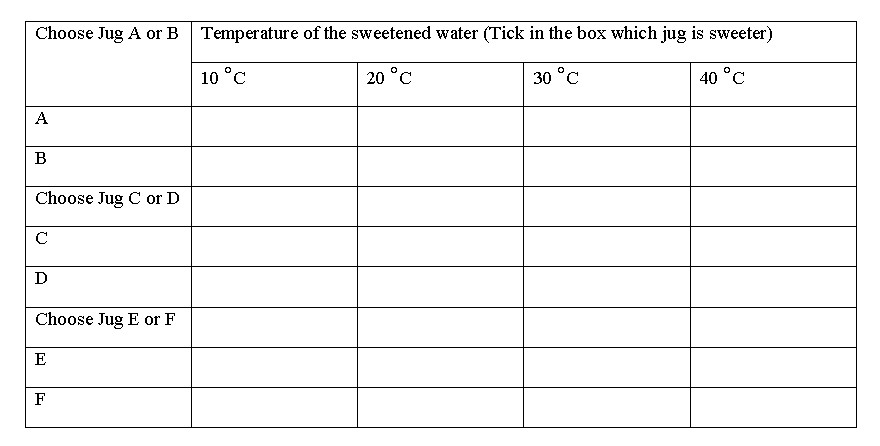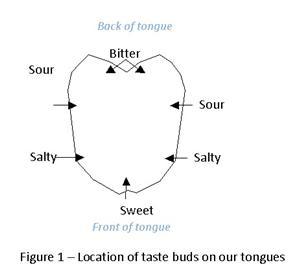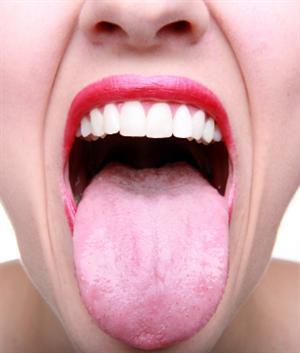| Complexity level: | 3 |
| Project cost ($): | 10 |
| Time required: | 1 hour to prepare, 2 hours for observation |
| Material availability: | Easily found |
| Safety concerns: | None |
Hypothesis
As the temperature of the sweetened water is increased, our ability to distinguish between a sweeter and a less sweet liquid is improved.
Overview
Sense of taste
Human beings have 5 senses ?sight, sound, smell, taste and touch. Taste enables us to appreciate the flavors in our food. It is this ability that helps us discern the different flavors in our food and heightens our enjoyment of the food.
The 4 basic types of taste are sweet, sour, salty and bitter. We are able to perceive taste with our tongues due to the specific areas of our tongue which are sensitive to that taste. The taste buds in these specific zones help up taste our food. Look below at Figure 1 to see where these taste buds are located. When food comes into contact with our taste buds, an electric signal is generated in our tongue. This electric signal is then sent to the brain through our nerves and we immediately recognize the taste.
Scientific Terms
Materials
The materials required for the experiment:
- 20 male and 20 female participants
- 6 jugs labeled A, B, C, D, E and F
- 240 plastic spoons for tasting
- 40 plastic cups
- 1 wooden spatula to mix sugar and water
- 1 packet of sugar
- 6 liters of cold drinking water
- Thermometer
- Oven
- Refrigerator
- Spoon to mix the sugar
- Small weighing machine to measure 20g to 100g weight.
Procedure
- For this experiment, the independent variable is the sweetness of the water and the temperature of the sweetened water. The dependent variable is the perceived sweetness of a sample from each jug by the participants. This is determined by having the participants do a taste test and through filling in a simple questionnaire. The constants (control variables) are sugar as the taste element.
- The sugar is added and mixed with the drinking water inside the jugs according to the ratio given in the table below. The jugs are also marked accordingly.
Mixture Jug A Jug B Jug C Jug D Jug E Jug F Sugar 10 grams 20 grams 50 grams 60 grams 90 grams 100 grams Water 1 liter 1 liter 1 liter 1 liter 1 liter 1 liter - Put all jugs in the refrigerator/freezer to bring the temperature of the drinks to 10 0C.
- Take out all the jugs and instruct the participants to use a plastic spoon to take a sample from each jug. They are to compare Jug A versus B, Jug C versus D and Jug E versus F. After tasting the sample, they are to spit out the contents into a plastic cup.
- Fill in the first column, ticking the 3 jugs that tasted sweeter when compared to the other sample. (e.g. Jug A is sweeter than Jug B. Therefore, tick A at 10 degrees Celsius)
- The procedure above is repeated by bringing the temperature of the sweetened water to 20 0C (almost room temperature), 30 0C and 40 0C. An oven maybe used to raise the temperature of the water. Fill in their responses as they see fit.
- The participants are given a form to fill out the result of their tasting experiment.

- Calculate the number of ticks for each comparison and find the percentage that chose B over A, D over C and F over E. Tabulate your results.

Results
The result shows that increasing the temperature of the water improves the perception of taste in the participants.

Conclusion
The hypothesis that increased temperature of the food increases our ability to distinguish sweetness levels is proven to be true.
If we are able to perceive sweetness better with our tongues, when food is warmer, we can then cut down our sugar intake by switching from cold to hot drinks. This way, we will be consuming less sugar and satisfying our cravings at the same time!
Also consider
The experiment can also be done using salt instead of sugar.
What is the ideal temperature of food for it to be perceived as tasty?
Would placing a sweet at the back of our tongues result in a reduced ability to perceive or taste sweetness as compared to placing it at the front of the tongue?
References
- Taste - http://en.wikipedia.org/wiki/Taste
- How temperature influences our taste - http://www.medicalnewstoday.com/articles/35142.php

